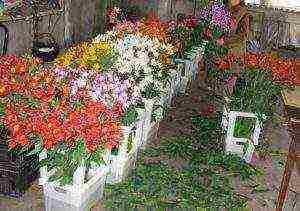Content

Today I want to show you how I grow mushrooms at home - oyster mushrooms.
It is very simple and not troublesome. Sow mycelium once and pick mushrooms for 3-5 years. With this method of cultivation, mushrooms turn out to be very fragrant - like grown in the forest and radically different in taste from store ones.
Each of you has the opportunity to grow eco-mushrooms in a garden plot on a stump.
I sowed mycelium for the first time 3 years ago - today is the fourth spring. This spring I decided to expand my plantations and at the same time tell everyone - because, as I am always asked a lot of questions.
Conifers are NOT SUITABLE for planting oyster mushrooms. The best for planting are deciduous trees: poplar, apple, cherry, oak, alder, beech, chestnut, ash, maple, poplar, birch, aspen, walnut.
Oyster mushroom grows especially well on walnut and poplar stumps.
The harder the wood, the longer the stump will last, and the more mushroom yields will grow on it.
The planting site for oyster mushrooms is a very important factor.
Oyster mushrooms do not really like places where the sun is too bright or a large open space. Therefore, it is better to plant oyster mushrooms under the trees in the garden. For example, oyster mushrooms grow well under a spreading walnut, well, or under other trees. Trees will shade the hemp with their crowns. Remember that the oyster mushroom planting site must be open to rainfall. This will save yourself the trouble of watering the mushroom garden.
You can use plots along the sheds and other structures on the north side.
Initially, I put stumps along the fence - between the building and the fence. There is a distance of about half a meter. It's enough. The main thing is not to put it under a canopy - so that the stumps are watered with rain.
To populate the mycelium, we need hardwood hemp - the size of the cuttings can be different - from 30 to 50 cm in length and 15 to 40 cm in diameter. The main thing is that the wood is healthy and there are no signs of mold infestation.
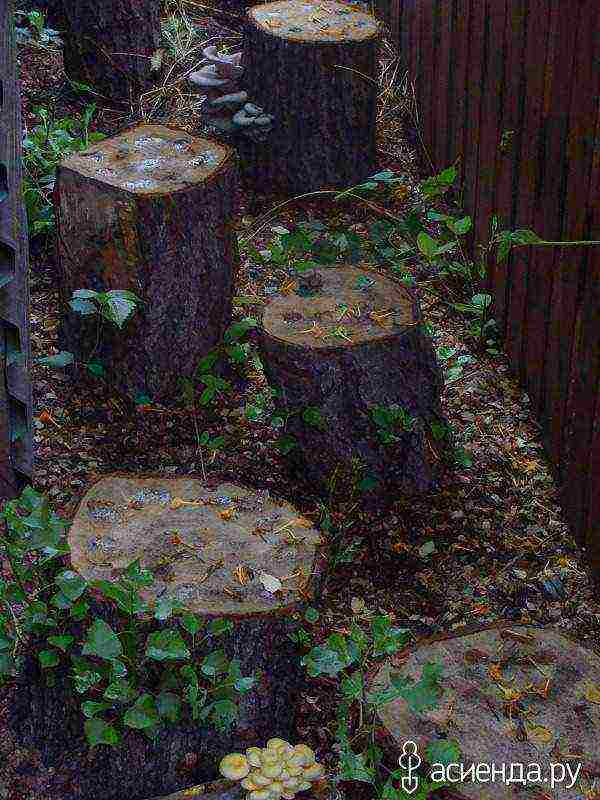
Prepare a tree stump for direct planting. It should be freshly cut, not old (dry). If the hemp is about a month old - place it in water for a day - so that it becomes wet. But, of course, it is better to use freshly sawn stumps for breeding oyster mushrooms. Then a successful result will be guaranteed.
We take the hemp, drill holes with a diameter of about 1-2 cm in them.It is possible smaller, but the smaller the diameter, the more difficult it is to fill it with mycelium. Number in random order 6-8 holes on top and 4-6 holes on the side. IMPORTANT: The stump should stand vertically with its top up, that is, as a tree grew in nature, so put the stumps, do not change direction, turning the stumps upside down.
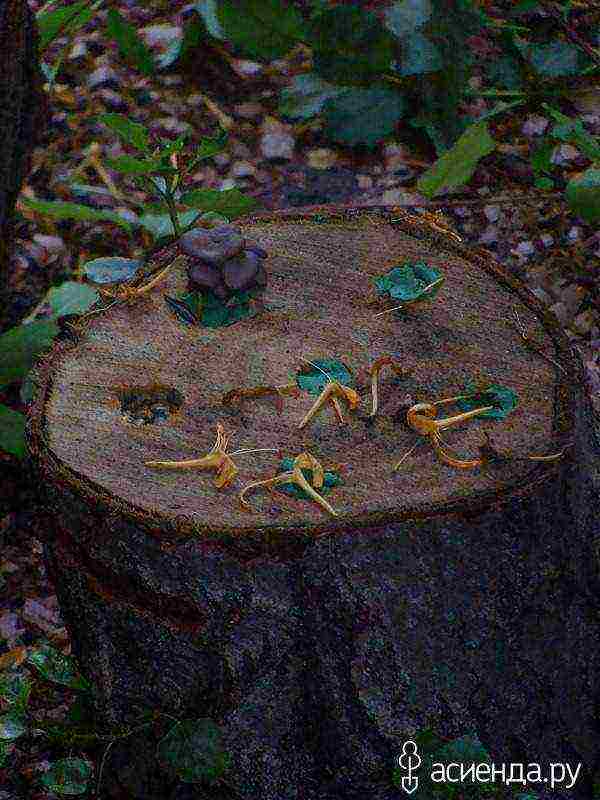
We fall asleep the mycelium. For convenience, we take a pencil (or other tamping device), put the mycelium into the holes, tamping it tightly with a pencil (stick, mortar, suitable in size) - do not worry, nothing will happen to the mycelium. The holes must be closed. You can close it in various ways - you can use plasticine, moss, duct tape, or, most conveniently, with a garden pitch. Some are even covered with cement. Mushrooms do not necessarily grow from these holes, they sprout inside the stump and come out anywhere

To install the stump, we dig a small hole - the depth is about 5 centimeters, put the stump in the holes and sprinkle the sides with earth. This is so that the stump is more stable and pulls moisture from the ground. Grass can grow around the stump. For more moisture, you can sprinkle mowed grass around, fallen leaves, etc., so that the soil remains moist longer.

They planted it, watered it around and that's it. We are waiting for the harvest.
If the summer is dry, the stumps can be watered. But do not pour water directly on the stump, the mycelium does not like direct ingress of water, only moisture. That is, you can water the stumps with a fine spray

This year I decided to increase my mushroom plantation.
My husband just howled at my message that he needed to "prepare" the stumps again. By the way, it's not easy to drill them.
Buying mycelium in the society of mushroom growers, I got into a conversation with their technologist (gored me with questions) and he suggested to me a less laborious way to populate hemp with mycelium.
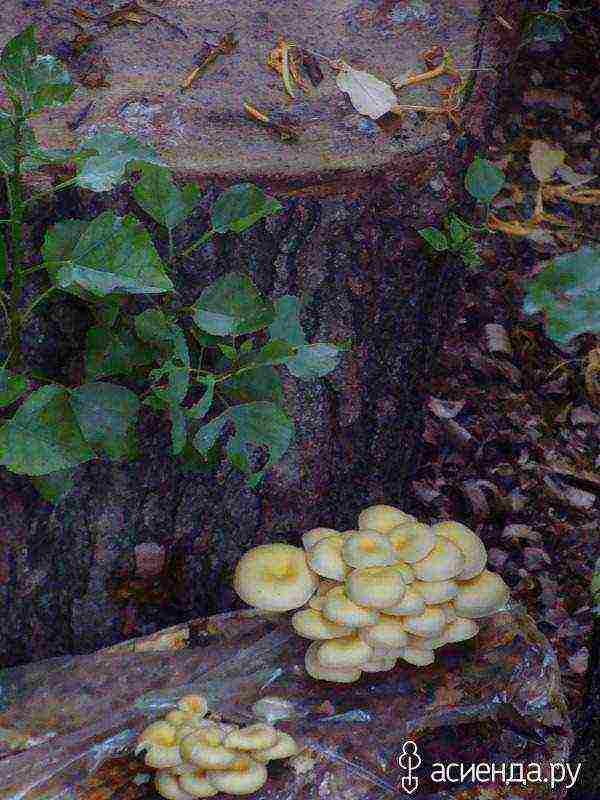

All ingenious is simple.
We dig a hole - a little less than a bayonet chipping - 15 centimeters, well 20.
The width is slightly wider than the harvested hemp.
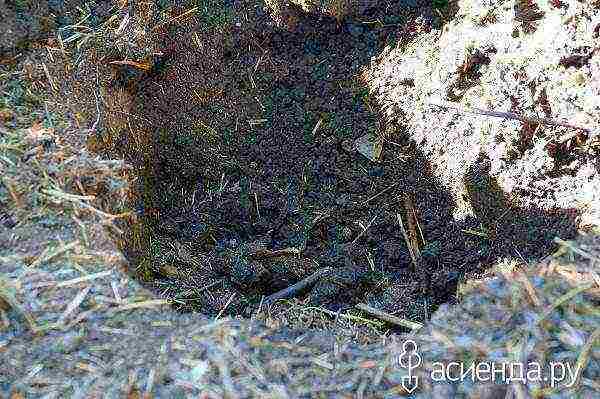
We put a pillow on the bottom - 5 centimeters. It is possible a little more - not fundamentally.
This can be sunflower husks, dry moss, shavings or sawdust of deciduous trees.
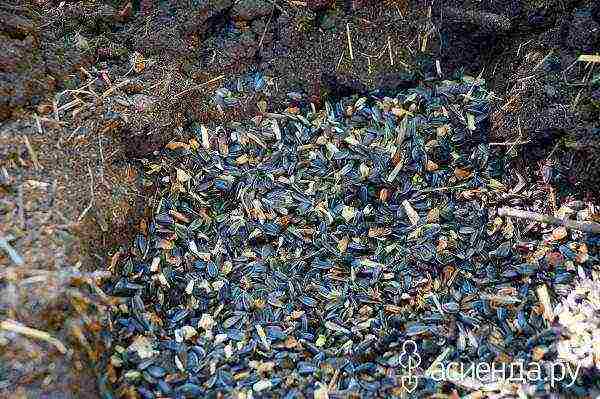
Water the hole with a pillow abundantly and pour mycelium on top - about 2 centimeters. About a handful of grain mycelium on a stump.
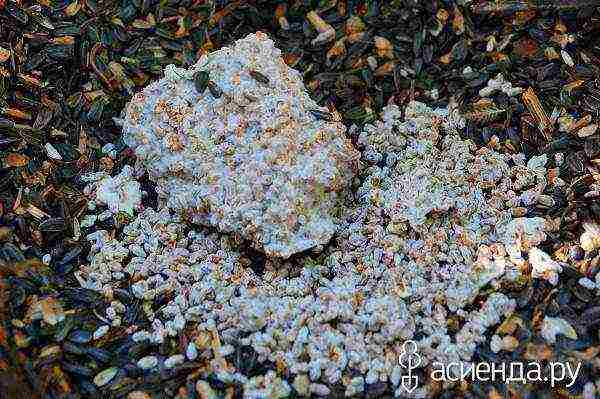
My mycelium is settled on a grain basis (wheat). I bought this mycelium from the mushroom growers' community in our city. A pack of mycelium - 2 kg costs 106 rubles today. This pack is enough for 5-6 stumps. You can search for mycelium online or search for a mushroom growing community in your area.
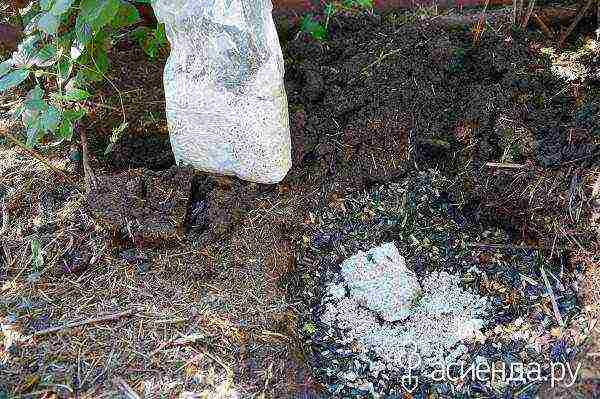
Prepared fossa

We put a stump on the mycelium.
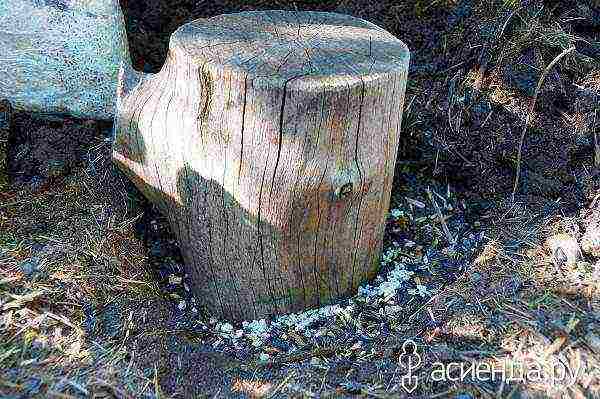
Sprinkle the sides with earth (no need to tamp) and water abundantly around.


This is a general view of the place where I "planted" a stump this year - along the fence under the raspberry bushes, from above they give a shadow of the crown of large cherries.
A great place for stumps is under the spreading walnuts.
There is practically no need to look after your mushroom plantation.
Nature will take care of the good harvest itself. However, if the planting was done in the wrong place, for example, too sunny, periodic watering will be necessary.

This method of growing oyster mushrooms will allow you to get a harvest of mushrooms in the same season. Moreover, you will receive mushrooms all year round - from the beginning of warm days to December (in the south, when there is no frost). Each stump will bear fruit until it completely disintegrates into parts. Such a mushroom plantation can feed you for 3-5 years, but the largest harvests occur in the second and third years. Mushrooms with 10 stumps are more than enough for one family - and we fry and pickle and preserve for the winter.
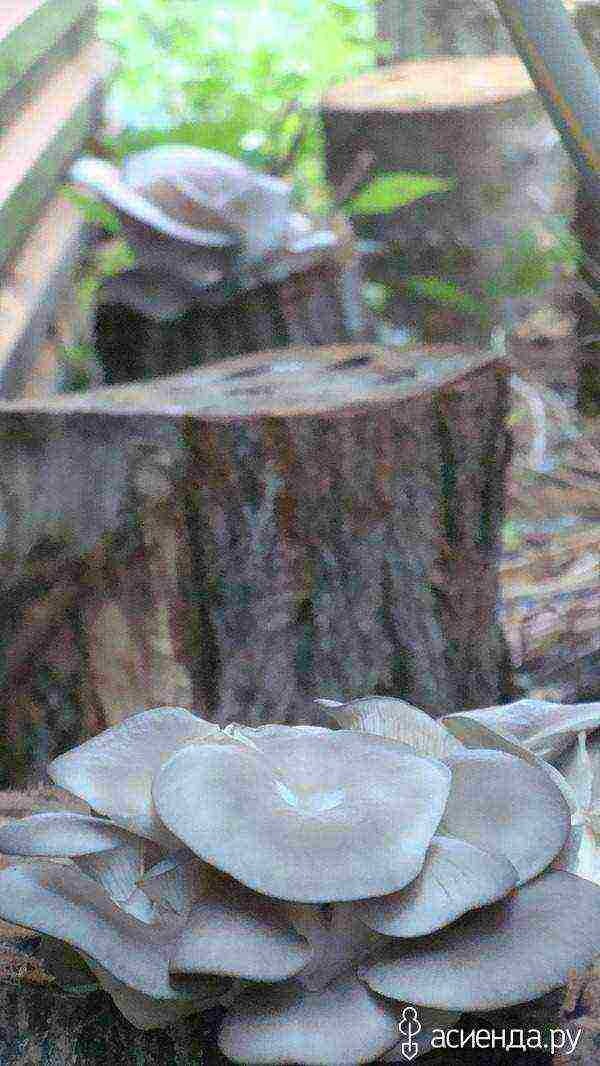
If stumps from felled trees remain on your site, you can use them, but they should be sown with mycelium only in April-May, when the temperature is above zero.
Oyster mushrooms on stumps during spring planting appear in August-September, and with a prolonged autumn, the harvest can be harvested until December. In cold regions for the winter, hemp is well covered with spruce branches, straw or foliage.
I'm not covering anything.
Now you know how to grow oyster mushrooms on stumps.

Growing mushrooms at home allows you to pamper yourself with this tasty and healthy product all year round, and can also become an excellent source of additional income. Oyster mushrooms are one of the simplest types of mushrooms of their kind. Anyone who has decided to try their hand at mushroom growing can feel like a master growing oyster mushrooms. This variety is very unpretentious and does not require special care. Where is the best place to grow oyster mushrooms at home and what is needed for this? Let's try to figure it out!
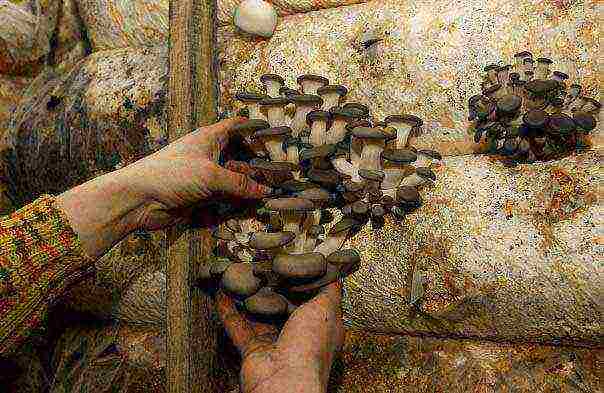
Features of growing oyster mushrooms: necessary conditions and premises
Oyster mushrooms or oyster mushrooms are a unique species that can sprout on any soil, be it dry grass, thyrsa, coffee grounds or even cotton fabric. This stunted plant is able to extract nutrients from everything in its environment. Another advantage of the species is its fast growth rate. Already two weeks after sowing, the first crop can be harvested.
Growing oyster mushrooms does not require any special knowledge and skills. The best place for growing oyster mushrooms will be the basement or cellar of a private house. Oyster mushrooms are not thermophilic and do not need a lot of light. If you do not have a basement, they can be grown in a greenhouse in a country house or shed. Despite the simplicity and the absence of excessive maintenance of mushrooms, the growing room must be properly prepared.
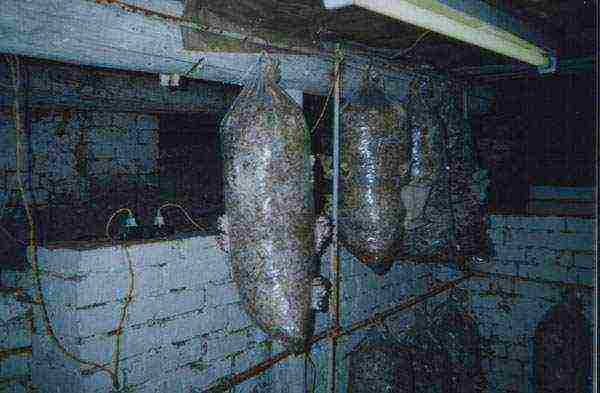
The following equipment should be installed in the room and special conditions for growing oyster mushrooms should be created:
- Growing equipment (bags). The choice of equipment depends on the method of growing oyster mushrooms. The most convenient and economical option is bag cultivation. To do this, you need special supports with hangers on which the bags with the substrate are suspended. It is best to use plastic equipment, it does not corrode and is much cheaper. By the way, oyster mushrooms can also be grown on stumps.
- Room temperature. This mushroom does not need high temperatures, so there is no need to create a greenhouse. It will be enough to insulate the room and carry out thermal insulation to retain moisture. Naturally, elementary heating devices must be present so that the temperature does not fall below 13 ° C. An elevated temperature is necessary only at the initial stage after planting the mycelium (22 ° C - 25 ° C). Infrared lamps can be used for additional heating.
- Humidity. Oyster mushrooms are very fond of moisture, so the air in the growing room must be constantly humidified. It is very easy to do this using nebulizers or special electronic humidifiers. The humidity level should be around 70-90%.
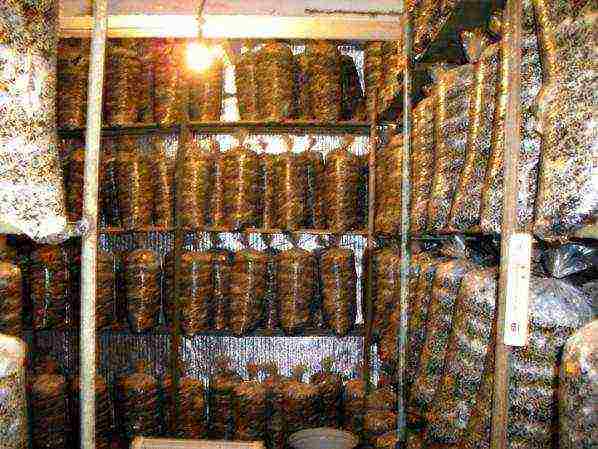
- Ventilation and lighting. All mushrooms grow in the fresh air and oyster mushrooms are no exception. The room must be systematically ventilated. This can be done manually, or you can install special hoods that will deliver fresh air. Again, purchasing such equipment is expensive, so unless you plan to grow large quantities of oyster mushrooms for sale, it won't be cost effective. When it comes to lighting, you need to install fluorescent garden lamps. You won't need a lot of them, since this type of mushroom does not require a lot of light.
- Cleanliness and pest free. To grow a large, and most importantly, a healthy harvest, the premises must be clean. If the basement is heated by groundwater, and there is fungus or bloom on the walls, this can seriously affect the yield. Mushrooms will hurt, light spots will appear on them, mushrooms will lose their density, become soft. To protect future plantings, it is necessary to disinfect the premises. First, they thoroughly clean the walls, ceiling and floor, remove all dirt and mold. Then, all surfaces are sprayed with a solution of sulfate, and the walls and ceiling are covered with a solution of lime and copper sulfate.
Video: a room for growing oyster mushrooms in the basement
Note! If there is a fungus in the room, it is better not to use it as a greenhouse. High humidity, which is necessary for growing mushrooms, will only aggravate the situation, the disease will affect crops, they will become inedible and poisonous.
How to grow oyster mushrooms at home: growing technology
Having decided on the location of the mushroom greenhouse, after thoroughly disinfecting the premises and installing the necessary equipment, you can proceed to the very process of growing the mushrooms.The technology of growing oyster mushrooms involves several stages.
Video: step-by-step instructions for breeding oyster mushrooms at home
Substrate preparation
The key to a rich harvest is a high-quality substrate. Although it is generally accepted that oyster mushrooms are indiscriminate in this regard, the soil should still be fertile.

The best substrates for breeding oyster mushrooms are:
- dry straw of wheat, barley and buckwheat;
- hardwood sawdust;
- sunflower seed husks;
- dried stalks and cobs of corn.
Choose the amount of substrate according to the amount of mushrooms you want to grow. So, one bag for growing oyster mushrooms is designed for 5 kg of substrate. All components of the substrate must be clean and dry, they must not have mold or rot, and they must not be rotten. It is best to disinfect the selected substrate by heat treatment. Next, you need to grind these components to a fraction of 4-5 cm and mix. Repeated heat treatment for two hours and squeeze out.
Actually, the substrate for growing oyster mushrooms is ready.
Selection and purchase of mycelium
For growing oyster mushrooms at home, it is best to use grain mycelium. It is very convenient to sow and does not require additional processing.
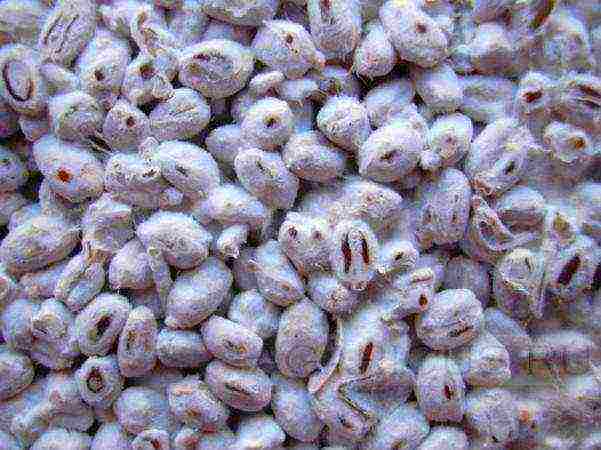
When buying mycelium, pay attention to its appearance. The grains should be yellow with a slight orange tint. It is strictly forbidden to buy mycelium, on which dark spots are visible - this is the first indication of the presence of mold. You can also determine the quality of the planting material by smell, it must be fresh and smell like mushrooms. If you smell a slight ammonia smell, it means that the mycelium was stored incorrectly and has deteriorated.
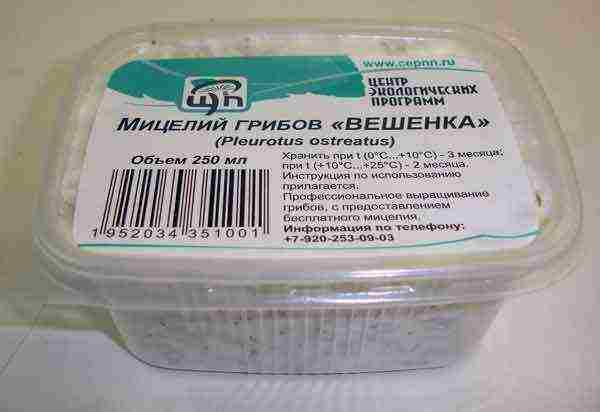
Be sure to pay attention to the manufacturer's company, it is better if it is a well-known and large manufacturer in the seed market, read reviews of gardeners on the Internet. Do not buy large quantities of mycelium at once, take a trial batch. If the mycelium germinates without problems, forms good and healthy myceliums, you can purchase a large batch.
If you want to make your own oyster mushroom mycelium, then read this article.
Landing
Before proceeding with planting, the mycelium must be placed in a room where oyster mushrooms will grow for a day. This is done in order to equalize the temperature and the mycelium does not die from shock.
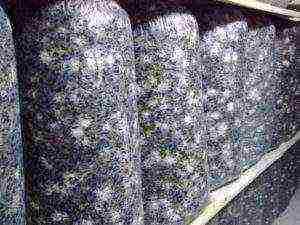
To grow oyster mushrooms in bags, it is imperative that it first be disinfected or thermally treated. An effective way of processing is washing with a solution of bleach.
The optimal volume of the bag should be at least 5 kg.
Further, the planting of oyster mushroom mycelium or the formation of mushroom blocks is as follows:
- There is a layer-by-layer filling of the bag with a substrate and mycelium. For every 5 centimeters of the substrate, there should be about 0.5 cm of mycelium. The top and bottom layers in the bag should be substrate.
- At the end of the filling of the mushroom block, the bag is tightly tied at the neck.
- Then small holes are cut at a distance of 10 cm from each other, with a diameter of no more than 2 cm. The cuts are best done in a checkerboard pattern.
Attention! The planting of mycelium and the cultivation of oyster mushrooms are carried out in separate rooms, since there is a high risk of infection of myceliums.
Video: how to make a perforation of a mushroom block
Further care
In the period from planting to the formation of myceliums, temperature room air should be 18 ° C - 20 ° C. As soon as they are visible first fungi formations, the temperature is lowered to 13 ° C - 15 ° C. This is the optimum temperature for growing all types of oyster mushrooms.
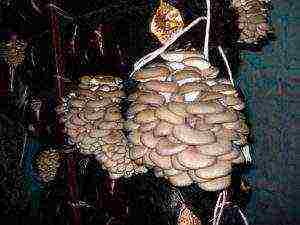
It is very important to maintain humidity air. Watering the substrate is strictly prohibited, since the mycelium begins to rot in wet soil. Even if the myceliums survive, all the mushrooms will hurt, rot and dark spots will begin to appear on them.To achieve optimal humidity in the room, you can hang wet sheets or any other wet cloth. Open containers with water are left near the heating devices, in this way the moisture evaporates faster and saturates the air.
Harvesting
The fruiting period for oyster mushrooms is only 30 - 35 days, which is a very short period. The thing is that these mushrooms have a very high frequency of fruiting: every 7 to 9 days. That is, already 9 days after planting the mycelium, you can harvest the first full harvest.
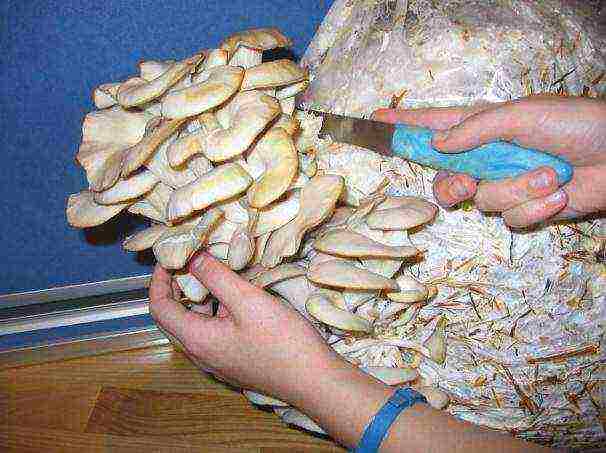
It is customary to cut the mushrooms with a knife carefully so as not to damage the main root attached to the mycelium. When collecting mushrooms, absolutely all fruits cannot be cut from one mycelium. It is necessary to leave 2 - 3 of the smallest mushrooms on the stem, otherwise the mycelium may dry out and stop bearing fruit.
Video: how to properly harvest oyster mushrooms
Important! After the last crop of mushrooms has been harvested, the substrate and bags must be disposed of. They are not recyclable. The room is well cleaned, ventilated and disinfected. It will be possible to re-breed mushrooms only 2 weeks after all harvesting work.
Video: technology for growing oyster mushrooms
Oyster mushroom diseases and pests: control measures and precautions
It happens that during the fruiting period, the mushrooms begin to hurt. A variety of factors can be the cause of such diseases. If all disinfection work has been carried out in the room, diseases should not disturb the crop.
The main number of fungal diseases lies in the substrate... As a rule, bacteria enter along with wet and rotten straw.
Important! If you are not sure about the quality of the substrate, it heat treatedbefore planting the mycelium. It is placed in a large container and poured with boiling water, after which it is boiled for 2 hours, then squeezed and dried.
In a damp substrate, the mushrooms begin to rot, the legs darken and become soft. This disease is called dark rot. If, nevertheless, she overtook the plantings, it is necessary to remove all diseased plants along with the substrate.
Very often oyster mushrooms are attacked mushroom flies, a little less often - ticks. These parasites are also born in the mycelium when the air is too humid and the room is not ventilated. Light pits appear on the mushrooms, like small bites. Naturally, such mushrooms must be removed immediately, and the room must be disinfected. Do this with smoke bomb, which is left for a day in a hermetically sealed room, and then thoroughly ventilate it.

It is necessary to carefully monitor the state of the mushrooms from the formation of the mycelium to the last fruiting. If one of the myceliums is infected, the entire bag will have to be thrown away, and this will significantly reduce the yield increase.
Summarize. Based on all of the above, it can be understood that growing oyster mushrooms at home is a very simple but time-consuming process. To do this, you will need to purchase special equipment, prepare the premises and fertile soil, and purchase high-quality mycelium. Further, it all depends on your patience and hard work. With proper care, up to 9 kg of mushrooms can be harvested from one bag. Growing oyster mushrooms is a great option for getting your first experience in mushroom growing.
Video: how to grow oyster mushrooms at home
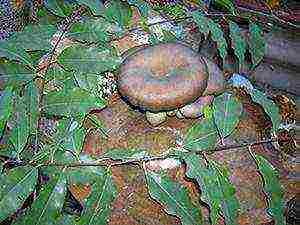
Oyster mushroom grows on trees of many species, including larch, cedar, bird cherry, apple, maple, elm, acacia, hornbeam, oak, poplar, alder, aspen, linden, maple and others. Growing oyster mushrooms on other wood species is ineffective. The wood must be healthy, free from mold and mildew.
Extensive cultivation of the mushroom can be carried out on wooden chocks, including in the conditions of a personal plot: the plantation is placed in the most shaded place.
Also suitable for growing oyster mushrooms and a basement.On stumps, oyster mushrooms can be rotated from the end of March.
This method does not require large investments and energy costs, since for growing oyster mushrooms by this method there is no need for special rooms, complex procedures for preparing the substrate.
Preparatory work
We prepare chocks (hemp) of soft deciduous trees. The diameter and length can be arbitrary, but it is more convenient to use chocks with a diameter of 200-300 mm. and a length of 300-400 mm.
Dry chocks are soaked for several days or poured abundantly with water from a hose. It is not necessary to soak freshly cut wood. It is necessary to determine the top of the hemp (in the direction of the tree's growth). Then, in the stumps from above, at a distance of 2-3 cm from the edge, we drill holes with a diameter of 1.5-2 cm (the wider, the easier it is to fill up the mycelium) and 10-15 cm deep (for the whole drill) in a circle, you can make one hole in the center if the stump is wide. Another 5-10 pieces in the sidewalls of the hemp evenly in a circle.
Sowing mycelium
Next, buy mycelium and knead it to separate grains.
We fill the holes with mycelium at the rate of 350-500 grams, depending on the size of the hemp.
We cover the holes with clay or plasticine (you can clog it with a wooden cap or plug it with cotton wool).
Accommodation
Next, you need to install the hemp in the place designated for them. The place must also be prepared as follows: under each stump, dig a hole, 10-15 cm deep, then put a stump in it.
Sprinkle the hole with sawdust, sunflower husk or earth.
It is better to choose damp, ventilated, shaded places: near the house, under bushes or trees. Let the grass grow around.
The land around should not dry out: in dry weather it is watered daily at the rate of 3 liters of water 1 square meter. This has a beneficial effect on the future harvest.
Fruiting
After a while, the mycelium grows inside and wants to go out in the form of a white, cotton-like bloom. The first mushrooms appear in 4-5 months. Mature mushrooms should be broken out or carefully cut, taking care not to damage neighboring young mushrooms. Most often, oyster mushrooms are collected by whole families. The growth of oyster mushrooms continues until the onset of severe frosts.
The mycelium hibernates well (for the winter, plantings are covered with spruce branches, burlap, branches) and fruiting lasts several years until the wood chock turns into dust.
Additional income
So, you have decided that you want to grow oyster mushroom for yourself on stumps, hemp, logs, wood.
In this case, you must have:
- stumps or low-grade hardwood,
- mycelium,
- a tool for drilling or sawing wood,
- the place where the planted wood will be placed.
You also need to choose the right time for sowing oyster mushrooms on wood.
The best time of the year in temperate latitudes is spring. Sowing in the fall is somewhat worse. This is determined by the developmental biology of the oyster mushroom. The optimum temperature for the development of mycelium (mycelium) and the temperature of fruiting do not coincide with each other.
For the so-called intermediate varieties of oyster mushroom, the range of the optimal temperature for the development of mycelium is 20-28 degrees, and the optimal fruiting range is 10-20 degrees. Since fruiting occurs after the development of the mycelium, such a sequence of biological stages of oyster mushrooms corresponds to the natural sequence of temperature conditions "spring-summer-autumn". Therefore, oyster mushroom sown on wood in spring, as a rule, yields a harvest in autumn, i.e. in six months. And oyster mushroom, sown in autumn, may not yield a harvest in spring. In this case, the harvest will be in the fall, i.e. in a year.
So, they select wood that is not inhabited by other mushrooms. This is freshly cut wood or one that does not have white, dark, red, etc. on the cut. stains. The thicker the wood, the better. If the diameter is less than 15 cm, then the oyster mushroom yield is insignificant.It is better to use such hardwoods: poplar, aspen, walnut, willow, birch, hornbeam. On oak and beech, fruiting occurs later, but the yield is greater.
The wood is cut into pieces of 35-40 cm. The logs are buried in a shady place in the ground by 1/3 or half. At the bottom of the hole, you need to pour sawdust in a layer of 1-2 cm.And put 50-100 g of seeds on the sawdust. Put a piece on the seeds.
According to the first method, the seed is placed under the lower saw cut with a layer of 5-10 mm. The advantage of this method is that the logs do not require any maintenance, you just have to wait for the harvest. There is only one drawback: oyster mushrooms colonize wood relatively slowly, and weed fungi can settle on the upper cut.
Therefore, you can use the 2nd method, according to which 3-4 holes with a diameter of 10-12 mm and a depth of 5-10 cm are made in each segment on the side in the ground part. The seed is placed in the holes. Logs are buried in the same way, but less seed (3-5 mm) can be placed on the bottom of the hole.
If you dig in the logs in spring or autumn, then the first harvest can be obtained in the coming autumn or spring, respectively. Typically, fruiting begins after a year. Stumps can also be used.
The fruiting period depends on the thickness of the logs and is usually 2-3 years. On thick stumps and logs, you can get stable yields for five years without any maintenance of the mycelium.
* * * * *
Question: Is it necessary to close the drilled holes in which the mycelium was laid? And if necessary, with what?
Answer: Yes, you should. The mycelium should be protected from precipitation with some kind of material. The classic way is to use sawdust, which is formed when drilling holes. The sawdust is permeable to air and allows the mycelium to breathe.
As for the use of other materials that are described on the Internet, for example, clay, foam and garden varnish, then I do not have enough statistics on the use of these materials for growing oyster mushrooms on wood.
Each mushroom grower can test these materials and independently make a conclusion about the appropriateness of their use.


